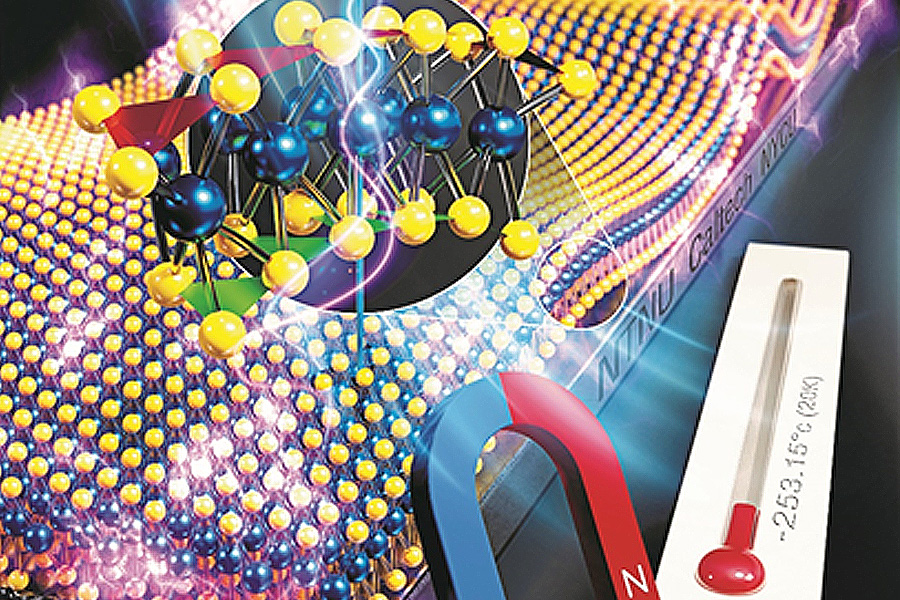A recent collaboration between the Department of Physics at National Taiwan Normal University and the California Institute of Technology (Caltech) has successfully overcome a key bottleneck in quantum memory technology. The study demonstrates that at extremely low temperatures, a magnetic field induces polarity ordering in monolayer molybdenum disulfide (MoS₂) transistors. This breakthrough is poised to bring revolutionary changes to the development of two-dimensional materials and electronic technologies.
Advancing International Collaboration and Quantum Technology Innovation
Under the collaboration of NTNU Physics professors Ting-Hua Lu and Yann-Wen Lan, postdoctoral researcher Wen-Hao Chang, NTNU Yushan Scholar and Caltech professor Nai-Chang Yeh, and Ph.D. student Duxing Hao, this research was officially published in the internationally renowned journal, Advanced Materials, at the end of December 2024. The work has attracted significant attention from the global academic community, and provides new directions for the development of quantum technology and the semiconductor industry worldwide.
This breakthrough not only showcases NTNU’s innovative capabilities in quantum technology, but also highlights the value of international scientific collaboration. The research was jointly supported by Taiwan’s National Science and Technology Council and the U.S. National Science Foundation, and was conducted in close partnership with Caltech, further strengthening the two universities’ collaboration in both fundamental science and high-tech applications.
This study focuses on monolayer semiconductor materials, particularly their structures characterized by strong spin–orbit coupling and the absence of mirror symmetry, which make the electronic valley effect a key feature. The research team found that at a low temperature of 20 K, the application of a magnetic field breaks the valley degeneracy in monolayer molybdenum disulfide (MoS₂), and induces real-space structural transformation, resulting in a pronounced polarization effect.
The research team designed a specialized field-effect transistor structure and, under ultra-low temperature and high magnetic field conditions, observed a large electrical hysteresis exhibiting a butterfly-shaped curve similar to that of ferroelectric materials. This technique overcomes the long-standing challenge in conventional ferroelectric materials, which lose their polarization when scaled down to the nanoscale. The team successfully realized a quantum memory material only 0.65 nanometers thick, featuring non-volatile memory characteristics and stable operation at extremely low temperatures.
The study further revealed that magnetic-field–induced asymmetric lattice expansion breaks the mirror symmetry of monolayer molybdenum disulfide, giving rise to ferroelectric-like polar ordering. This phenomenon not only provides a novel way to manipulate the physical properties of monolayer materials, but also opens up possibilities for applications in ultra-low-temperature non-volatile memory, highly sensitive magnetic sensors, and nanoscale electronic devices.
Potential Applications: Quantum Memory and Ultra-Sensitive Sensors
This material has significant application potential, particularly in the field of quantum memory. Its ability to maintain stable polarization even at low temperatures offers new approaches and possibilities for the development of quantum memory and in-memory computing technologies. As technology advances, this novel memory material could be further miniaturized, increasing storage capacity and computational speed, potentially driving breakthroughs in the field of quantum computing.
In addition, this technology also shows potential for operation in extreme environments, particularly in ultra-sensitive magnetic sensors and nanoscale electronic devices. The material’s unique properties make it an ideal candidate for next-generation high-precision sensing technologies, as it is capable of stable operation under ultra-low temperatures and strong magnetic fields, thus offering unparalleled performance for future sensors.
Ting-Hua Lu stated, “The professors in the Physics Department have maintained long-term and close collaboration with Professor Nai-Chang Yeh. This partnership successfully combined NTNU’s and Caltech’s experimental capabilities, not only verifying new physical phenomena of two-dimensional materials under low temperatures and magnetic fields, but also demonstrating Taiwan’s significant role in fundamental science and international collaboration.”
Yann-Wen Lan also noted, “Our close collaboration with Caltech has greatly facilitated the progress of this research. We hope this technology will become a cornerstone for the future development of quantum and semiconductor technologies and lead to breakthroughs in practical applications.”
The research team pointed out that this phenomenon may also be applicable to other monolayer transition metal dichalcogenides. By designing substrate-induced strain engineering, similar polar effects could be achieved. The results demonstrate the combination of innovative materials science with advanced nanotechnology, and are expected to have a profound impact on the electronics and optoelectronics industries in the future.
(This article was provided by The Center of Public Affairs.)
Source:
D. Hao, W.-H. Chang, Y.-C. Chang, W.-T. Liu, S.-Z. Ho, C.-H. Lu, T. H. Yang, N. Kawakami, Y.-C. Chen, M.-H. Liu, C.-L. Lin, T.-H. Lu, Y.-W. Lan, N.-C. Yeh, Magnetic Field-Induced Polar Order in Monolayer Molybdenum Disulfide Transistors. Adv. Mater. 2024, 36, 2411393. https://doi.org/10.1002/adma.202411393




